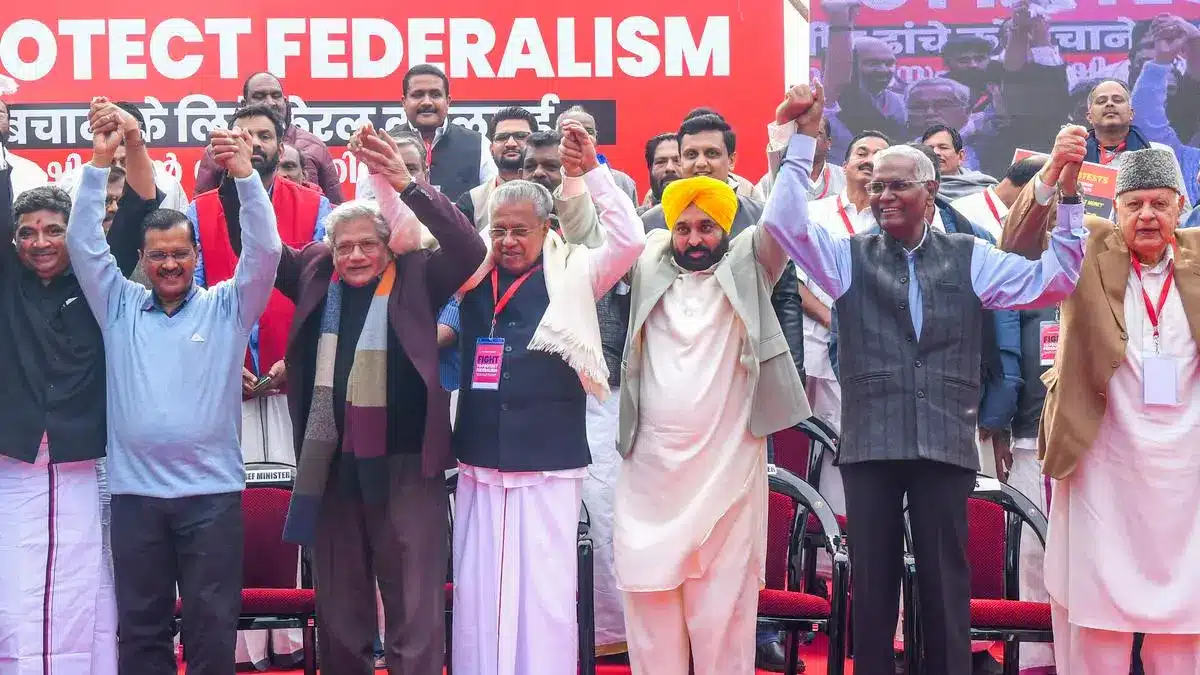What’s in today’s article?
- Why in News?
- Spending Priorities of the Union and the States
- Trends in Union and States Budget Expenditures
- Case of Kerala
- Borrowing by the State Government of Kerala
- A Case for Greater Market Borrowings by the Kerala Government
- Concerns Regarding Kerala’s Budgetary Expenditures
- Way Ahead
Why in News?
In a recent development, the Govt of Kerala has approached the SC for a resolution of the following question: how much can the State govt borrow from the market to bridge the excess of its expenditures over receipts?
The Supreme Court has referred Kerala’s plea for additional borrowing to a Constitution Bench.
Spending Priorities of the Union and the States:
- The spending priorities of the Union and the States are guided by the constitutionally allocated powers and functions for them.
- It is well known that in India the power to raise taxes rests largely with the Union government while a greater part of the overall government spending is done by the State governments.
- On social services (health and education), the expenditure incurred in 2022-23 was ₹2,230 billion by the Union government while the combined expenditure by all State govts was ₹19,182 billion.
- Compared to its expenditure on social services, the Union government’s spending on defence was approximately twice as high, while on transport, urban development and energy combined was 2.4 times higher.
Trends in Union and States Budget Expenditures:
- The Reserve Bank of India (RBI) has categorised the budgetary expenditures by the Union and the State governments as ‘developmental’ and ‘non-developmental’.
- The former includes expenditures on social services and economic services (such as on agriculture and industry) while the latter refers to interest payments, pensions, subsidies, etc.
- It is remarkable that developmental expenditures (particularly on social services) incurred by the State governments have risen significantly over the last two decades.
- As a proportion of the country’s Gross Domestic Product (GDP), the combined developmental expenditures by all State governments increased from 8.8% in 2004-05 to 12.5% in 2021-22.
- On the other hand, the social and developmental expenditures by the Union government remained somewhat unchanged over the two-decade period.
- This means, it was the spending by the State govts that has helped to alleviate the livelihood crisis in the country, caused due to the slow growth of rural incomes and employment.
Case of Kerala:
- Kerala provides an excellent illustration of the power of government spending to positively transform a region’s economy and society.
- The expenditure on social sectors as a proportion of the total budgeted expenditures by the State government in Kerala ranged between 40% and 50% between 1960-2000.
- This proportion was way ahead of the corresponding average of all other States until the middle of the 2000s.
- From the mid-2000s, while the average proportion of all other States rose upward, the proportion for Kerala stagnated.
- A substantial part of Kerala’s budget (6% in 2022-23) is now devolved to Local Self-Governments (LSGs).
- If the spending by the LSGs on social sectors is taken into account, the proportion for Kerala could still be higher than the average of all other Indian States.
Borrowing by the State Government of Kerala:
- State governments receive funds from three sources: own revenues (tax and non-tax); transfers from the Union government as shares of taxes and as grants; and market borrowings.
- In 2020-21, the Kerala government had sharply increased its spending to 18% of its GSDP, to provide economic relief in the wake of the COVID-19 pandemic, aided by the relaxation in borrowing norms then.
- As a ratio of GSDP, the Union government’s transfers to Kerala declined to 2.8% in 2023-24, significantly lower than previous years, even as the State’s own revenues remained at around 8.0%.
- This meant that the State government could meet its modest budget expenditure (equivalent to 14.2% of GSDP) only by raising the borrowing to 3.4% of the GSDPin 2023-24.
○ This would cross the borrowing limit set by the Centre (3% of the State’s income or GSDP).
A Case for Greater Market Borrowings by the Kerala Government:
- Higher spendings on the social sector will help build a facilitative environment for a knowledge-driven economy.
- Given the current state of federal fiscal relations, such an increase in government spending can occur only with greater market borrowings.
- A large part of the government borrowing in Kerala (as elsewhere in India) is from domestic financial institutions, including public sector banks (PSBs) and insurance companies.
- PSBs and insurance companies mobilise savings from the wider public and Kerala is a region with a large reserve of private savings.
- This could be channelled for productive purposes.
- The concerns about debt-financed government expenditures are often exaggerated.
- The government borrowing can generate a virtuous cycle if the borrowed resources are deployed effectively to create new incomes and jobs.
Concerns Regarding Kerala’s Budgetary Expenditures:
- A sizeable chunk of the government expenditure on social services is in the revenue account, paid as salaries and pensions.
- For example, the pensions paid to retired government employees as well as to members of the disadvantaged sections make up 16.4% of all budgeted expenditures by the Kerala government. This is markedly higher than the average proportion allotted for pensions by all Indian States (9.7%).
- It is indeed a concern that only 10.6% of Kerala’s budgetary resources was directed to capital expenditure (in 2022-23), which is much needed to build new infrastructure and institutions to speed up future growth.
Way Ahead:
- Kerala contends that by curtailing its borrowing powers, the Centre is undermining the State’s ability to fulfil some of its basic financial commitments and violating the principle of federalism.
- Many of the development dilemmas that Kerala faces today (ageing population, the large outgo for pensions, outmigration of its youth) are problems that most other States will also face in the coming years.
- Therefore, the Union and the State governments should join hands to ward off these challenges.
On its part, Kerala should be able to convince that its borrowing is part of a larger plan to rebuild the economy and not a firefighting exercise to meet immediate financing needs.
Q.1. How do states in India borrow money?
State Governments participate in market borrowing by issuing State Development Loans (SDLs). These securities, issued through auctions, serve as a means for state governments to raise funds. Like central government securities, SDLs qualify for SLR and can be used as collateral for market repo transactions.
Q.2. Why Kerala has better social indicators than other states in India?
Kerala has achieved a far better position in social indicators such as education among the other Indian States. This is because Kerala has higher literacy rate, higher enrolment rate of students, higher percentage of girl, SC and ST students in schools and colleges and low dropout rate among students.
Last updated on December, 2025
→ Check out the latest UPSC Syllabus 2026 here.
→ Join Vajiram & Ravi’s Interview Guidance Programme for expert help to crack your final UPSC stage.
→ UPSC Mains Result 2025 is now out.
→ UPSC Notification 2026 is scheduled to be released on January 14, 2026.
→ UPSC Calendar 2026 is released on 15th May, 2025.
→ The UPSC Vacancy 2025 were released 1129, out of which 979 were for UPSC CSE and remaining 150 are for UPSC IFoS.
→ UPSC Prelims 2026 will be conducted on 24th May, 2026 & UPSC Mains 2026 will be conducted on 21st August 2026.
→ The UPSC Selection Process is of 3 stages-Prelims, Mains and Interview.
→ UPSC Result 2024 is released with latest UPSC Marksheet 2024. Check Now!
→ UPSC Prelims Result 2025 is out now for the CSE held on 25 May 2025.
→ UPSC Toppers List 2024 is released now. Shakti Dubey is UPSC AIR 1 2024 Topper.
→ UPSC Prelims Question Paper 2025 and Unofficial Prelims Answer Key 2025 are available now.
→ UPSC Mains Question Paper 2025 is out for Essay, GS 1, 2, 3 & GS 4.
→ UPSC Mains Indian Language Question Paper 2025 is now out.
→ UPSC Mains Optional Question Paper 2025 is now out.
→ Also check Best IAS Coaching in Delhi

















